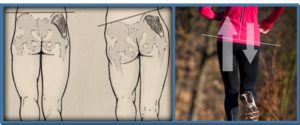Run away from injury!
the importance of hip abductor strength
by Jess Kennedy, Physiotherapist

Running is an ever popular form of exercise, but the runs aren’t always ‘fun’ especially when pain or injury rears its head. At Fusion, we commonly see lower limb injuries in frustrated runners wanting to be out there pounding the pavement.
It may be that those “niggles” you can’t shake and which don’t seem to resolve with a break from running, could be originating from a muscle weakness or imbalance that you weren’t aware of.
‘Lateral hip stability’, ‘pelvic control’ and ‘altered hip mechanics’ are common terms we hear thrown around. But, what do they mean? And where are we going wrong?
Illiotibial Band Friction Syndrome, Patellofemoral Pain Syndrome, Medial Tibial Stress Syndrome and Patella Tendon Pain seldom occur in isolation, and are often caused by poor hip abductor strength.
Our primary hip abductor muscles are gluteus medius (see below) and gluteus minimus; together with gluteus maximus they form the gluteal group and are primarily active during the stance phase of running. Abduction at the hip results in a stable pelvis as the opposite leg swings through. Weakness is this muscle group can cause a ‘hip drop’ as shown below can cause rotation through the pelvis, reduce stride length and change your landing position. Over time, these mechanical changes alter the load we expose our bodies to during running and can cause ongoing lower limb issues.
In a study comparing hip strength differences between runners with lower limb overuse injuries and non-injured runners, there were significant differences in the hip strength of the injured side versus non-injured side in the overuse injury group; comparatively there were no significant differences found between left and right sides in the non-injured group (Niemuth, et al., 2005).
Further, another study concluded that weakness within the hip stabilising muscles leads to atypical lower limb mechanics and increased forces experienced during running (Ferber, Hreljac, & Kendall, 2009).
There exists an abundance of hip stability exercises out there. Some of our favourites at Fusion Physiotherapy are bridges, side-lying hip abduction, theraband squats and sidesteps, and single leg exercises.
Niemuth, P. E., Johnson, R. J., Myers, M. J., & Thieman, T. J. (2005). Hip muscle weakness and overuse injuries in recreational runners. Clinical Journal of Sport Medicine, 15(1), 14-21.
Ferber, R., Hreljac, A., & Kendall, K. D. (2009). Suspected mechanisms in the cause of overuse running injuries: a clinical review. Sports Health: A Multidisciplinary Approach, 1(3), 242-246.



